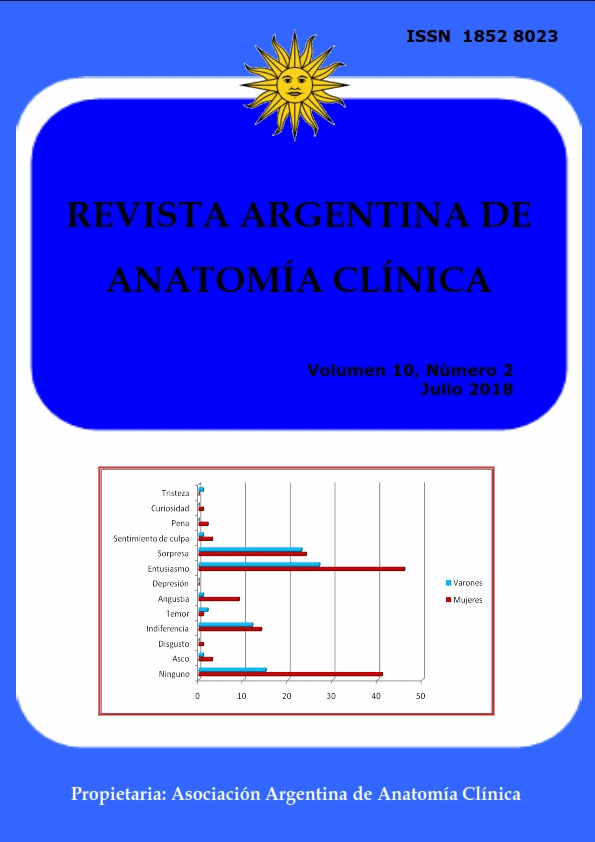LA PERCEPCIÓN DE LOS ESTUDIANTES DE PRIMER AÑO DE MEDICINA EN LA SALA DE DISECCIÓN Y SU INCIDENCIA SOBRE LA PROCURACIÓN DE CUERPOS. First year Medicine students’ perception at the dissection room and its incidence on body procurement
DOI:
https://doi.org/10.31051/1852.8023.v10.n2.19878Palabras clave:
cadáver, sala de disección, estudiantes de Medicina, donación de cuerpos, procuración de cuerpos,Resumen
El estudio consistió en evaluar el impacto que tiene en los estudiantes de primer año de Medicina el contacto inicial con el cadáver, tanto en trastornos físicos como emocionales, su modificación en el transcurso del cursado y la incidencia que tendría en su voluntad de donar el propio cuerpo o al propiciar la donación por parte de terceras personas. Se realizó mediante una encuesta con respuestas de múltiples opciones y algunas semiestructuradas, en una muestra de 191 estudiantes de primer año de Medicina. Casi la totalidad acordaron en la importancia del cadáver para el estudio de la Anatomía y de ésta para la carrera médica. Los síntomas más frecuentes manifestados por el primer contacto con el cuerpo fueron irritación ocular (54%), congestión o irritación nasal (52%) y olor desagradable (28%); mientras que las emociones más referidas fueron entusiasmo (38%) y sorpresa (25%). Se adjudicaron principalmente al olor de la sala (40%) y del cadáver (55%), y para superar estos trastornos los recursos más empleados fueron: centrarse en el tema (39%), ver el cuerpo como un objeto (29%) y el humor (20%). Solo el 29% donaría su cuerpo y el 83% donaría sus órganos para trasplante; a pesar que el 80% considera que los estudiantes de primer año deberían disecar y el 73% querría ser ayudante en la cátedra. Reconocen que falta información y concientización sobre la donación de cuerpos para docencia e investigación en Anatomía y consideramos que es imprescindible contar con un programa de procuración y donación.
Our objective was the evaluation of first year Medicine student’s perception at their first contact with the corpse in the dissection room. We considered as well physical and emotional aspects, change during the Anatomy course, impact on their will to donate the own body or propitiate other people’s donation. The study consisted on a survey with multiple choice and semi-structured responses, on a sample of 191 first year medical students. Nearly all agreed in the importance of corpses to study Anatomy and Anatomy for the medicine career. Most frequent symptoms on the first contact were ocular irritation (54%), nasal congestion (52%) and unpleasant smell (28%); while mostly mentioned emotions were enthusiasm (38%) and surprise (25%). Those perceptions were mainly caused by the room (40%) and the cadaver (55%) smell, and the resources used to endure them were: focus on the topic (39%), consider the body as an object (29%) and humor (20%). Only 29% of students should donate their own bodies and 83% should donate their organs for transplantation; instead 80% consider that first year students should dissect by themselves and 73% should like to be student-assistants at the Anatomy Chair. They recognize the lack in information on body donation for teaching and research in Anatomy, and we consider it is absolutely necessary a program for procurement and donation.
Referencias
Anyanwu EG, Obikili EN, Agu AU. 2014. The dissection room experience: a factor in the choice of organ and whole body donation—A Nigerian survey. Anatomical Science Education 7: 56-63.
Arraez-Aybar LA, Castaño-Collado G, Casado-Morales I. 2007. A study of cognitive-affective and physiologicalmotor reactions to human dissection in Spanish students of human Anatomy. Eur J Anat 11 (Supl I): 67-71.
Dereje G. 2014. Reaction of medical students to experiences in dissection room. Ethiop. J. Health Sci. 20: 337-42
Lee YH, Lee Y-M, Kwon S, Park S-H. 2011. Reactions of first-year medical students to cadaver dissection and their perception on learning methods in Anatomy. Korean J Med Educ 23: 275-83.
Miguel Pérez M, Porta Riba N, Ortíz Sagristá JC, Martínez A, Götzens García V. 2007. Anatomía Humana: Estudio de las reacciones de los estudiantes de primero de medicina ante la sala de disección. Educacion Médica 10: 105-13.
Onyije FM, Avwioro OG. 2012. Excruciating effect of formaldehyde exposure to students in Gross Anatomy dissection laboratory. Int J Occup Environ Med. 3: 92-95
Sándor I, Birkás E, Gy?rffy Z. 2015. The effects of dissection-room experiences and related coping strategies among Hungarian medical students. BMC Medical Education 15:73. doi: 10.1186/s12909-015-0355-9
Descargas
Publicado
Número
Sección
Licencia
Los autores/as conservarán sus derechos de autor y garantizarán a la revista el derecho de primera publicación de su obra, el cuál estará simultáneamente sujeto a la Licencia de reconocimiento de Creative Commons que permite a terceros compartir la obra siempre que se indique su autor y su primera publicación en esta revista. Su utilización estará restringida a fines no comerciales.
Una vez aceptado el manuscrito para publicación, los autores deberán firmar la cesión de los derechos de impresión a la Asociación Argentina de Anatomía Clínica, a fin de poder editar, publicar y dar la mayor difusión al texto de la contribución.



